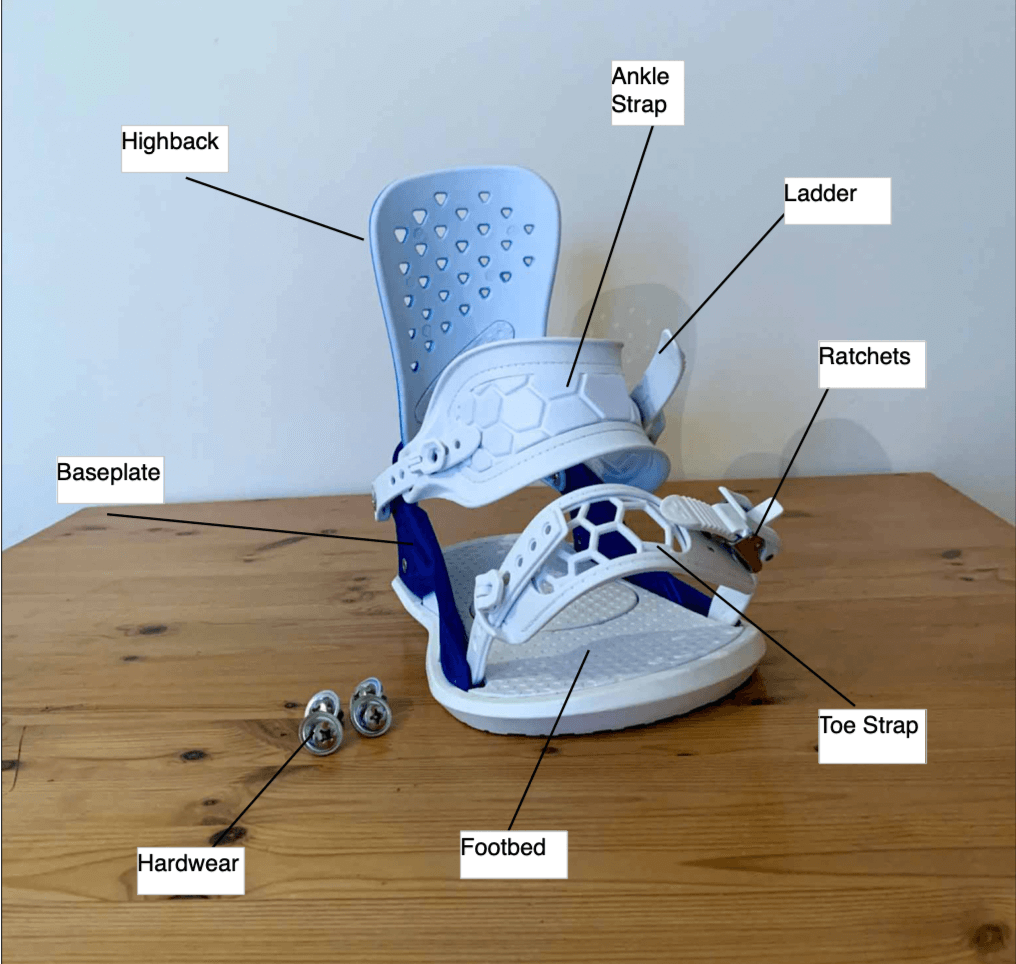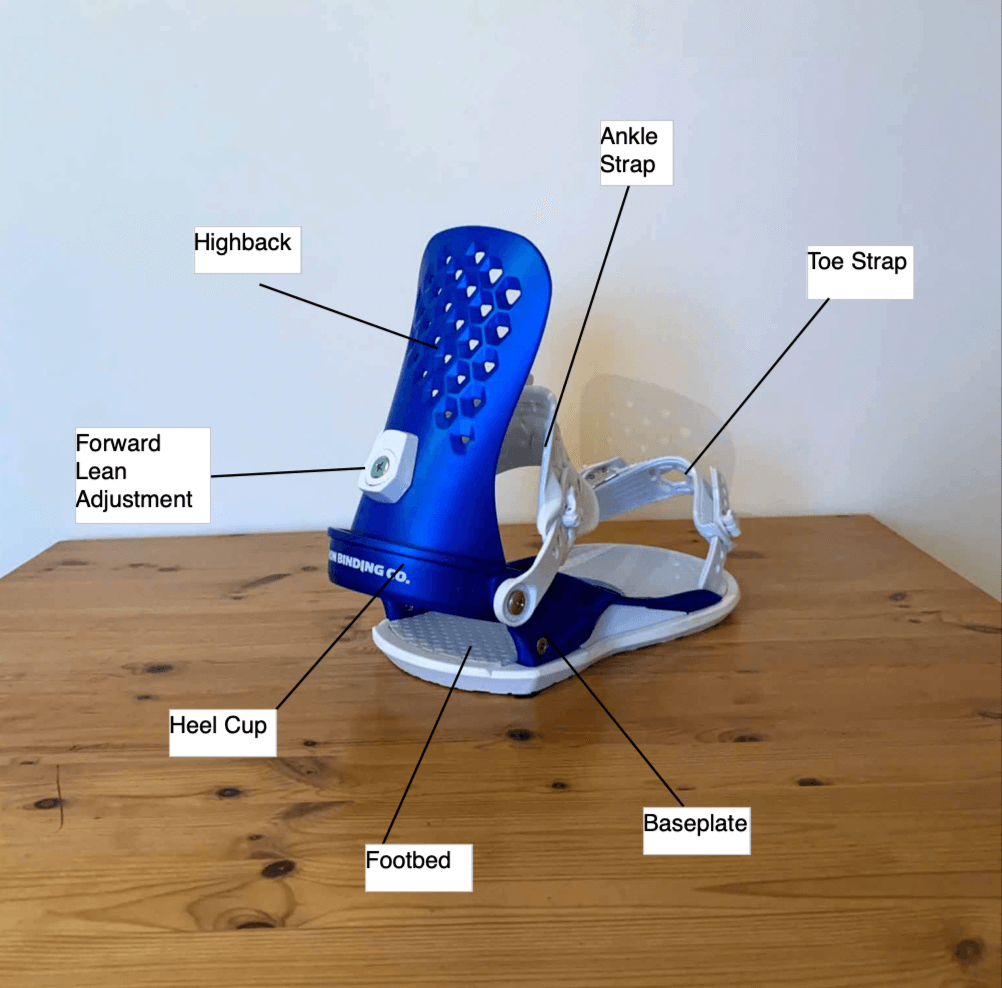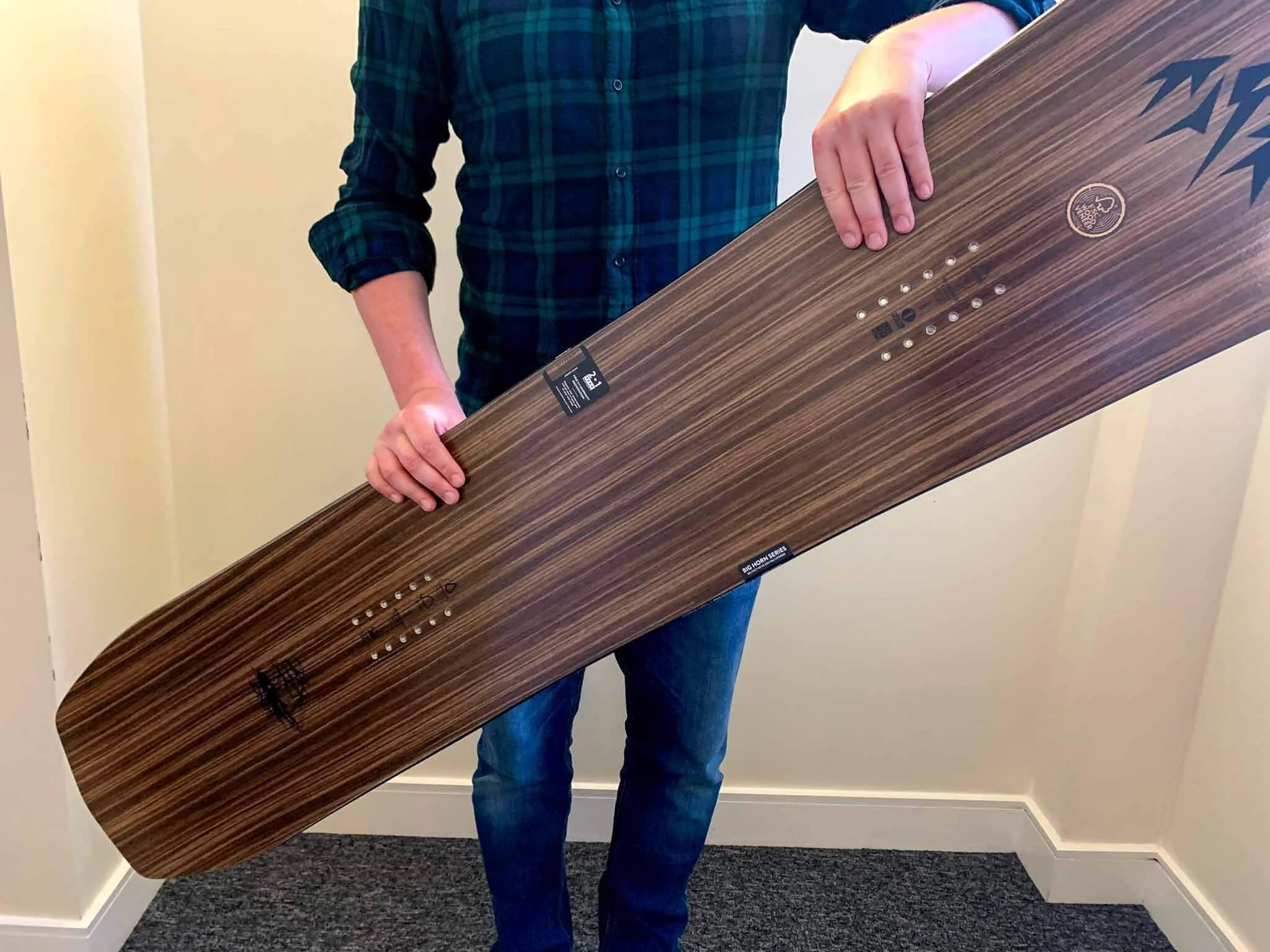SNOWBOARD BINDING BUYERS GUIDE
The link between boots and board, snowboard binding are a significantly important part of your set-up. Responsible for transferring power from your body to the board, the right pair of bindings will help you feel in full control.
Bindings should be matched to your boots and board for the best performance results. You should also consider the type of riding you want to be doing as this will influence your binding choice.
SNOWBOARD BINDING PARTS
Snowboard Binding Front View
Snowboard Binding Rear View
BASEPLATE
The baseplate is the piece of the bindings that you attach to the snowboard. On regular bindings, there is a circular cut-out in the middle of the base plate which is where you will screw the binding to the board. The other parts of the binding attach to the baseplate.
Most importantly the baseplate will deliver the power you generate to the board and it is important to consider the materials that the baseplate is made from. The stronger the materials, the more durable the baseplate.
FOOTBED
Each baseplate will have different levels of cushioning called the Footbed. It is important to consider the amount of cushioning a baseplate has as this will affect the snowboard’s feel. If you are hitting jumps consider a more cushioned Footbed as this will help absorb shock from landings.
HIGHBACK
The highback is the part of the binding that sits behind your boot. Highbacks come in different; shapes, sizes and flexes but the aim is always the same. Highbacks support the boot in the binding and help transition your boot’s movement to the baseplate.
Stiff highbacks can be less comfortable but will be more responsive than soft highbacks. Stiff highbacks are often found on top-end freeride bindings as they increase performance.
Soft highbacks are great for beginners are this is more forgiving. Soft highbacks are also great for snowboarders who like to press or jib their board. The softer flex allows them to move further in the binding.
Highbacks normally have an adjustment where you can add forward lean to increase performance. By increasing forward lean the binding will respond quickly to your movements.
Some bindings allow you to remove the highback for a more surfy ride. This is popular with some in powder conditions.
HEELCUP
The heel cup is the structure that supports your heel in the binding. The heel cup is essential as an attachment point for the highback which joins with the heel cup to prevent your foot from sliding out the rear of the binding. In most cases, heel cups are manufactured from strong durable polycarbonate. In lower-end bindings, a heavier metal may be used to construct the heel cup. Salomon snowboards use a soft heel cup and accompany this with a kevlar wire to allow the heel cup to move with your boot.
STRAPS
Bindings will have two straps to hold your foot securely in the binding. These straps are usually adjustable and allow for a range of boot sizes to fit within one binding size. The quality of the straps can be an indication of the overall quality of the binding. Lower-end bindings tend to have bulkier or less durable straps with premium bindings normally having lighter more comfortable designs.
ANKLE STRAPS
The ankle strap should be fastened first and pulls your boot securely into the rear of the binding. A variety of ankle straps are on the market. Look for comfort and durability as an uncomfortable strap will impact your enjoyment on snow.
TOE STRAP (TOE CAP)
The toe strap can be worn in one of two ways; over the top of your toes or across the end of your toes. This ultimately depends on the strap’s design and the rider’s preference. Whether worn over or on your toes, the toe strap pulls the forefoot back into the binding helping to transfer energy in both the heel and toeside turn.
RATCHETS
Ratchets are the lever that is used to tighten and loosen your binding straps. Ratchets allow you to customise the fit of the binding to the rider’s preference and help to ensure a tight fit. Pay attention to the ratchets as if they are made from cheap materials they will break a lot easier.
LADDERS
The ladders attach to the binding along the baseplate and are used for the ratchet to grip to create a strong hold over your boot. Again cheaper bindings will use cheaper plastics, causing them to wear out easier and need replacing.
FORWARD LEAN
Forward lean adjustment allows you to increase or decrease the angle of your highback. Riding with an increased angle will push your highback forward creating closer contact with your boot. This will help improve the responsiveness of the binding and will assist in creating a powerful riding position with your knees bent over your toes. Decreasing the forward lean is normal for people who like to ride rails and do not want as much edge contact with the snow or rails.
How To Mount Your Bindings
Mounting your binding involves tightening screws to attach to holes on your snowboard. There are 3 main ways to do this, however, only two are widely used. It is really important to check that the binding you buy is compatible with the mounting system on your board.
TRADITIONAL INSERTS
A traditional mounting system is what you will find on nearly all snowboards and has been used by all major snowboard manufacturers. The traditional mounting system involves using 4 screws, one in each corner of the insert pack to provide a stable platform for your snowboard binding. The traditional mounting system has stood the test of time and is the mounting system of choice for all brands except for Burton & Endevour (some brands like Signal offer boards in both traditional and channel systems). Traditional insert packs are compatible with both normal binding disks and minidisks. The mini-disk systems are used to increase the board feel.
THE CHANNEL/EST
The channel or EST system is a mounting system developed by Burton Snowboards. EST uses two channels rather than 4x4 inserts packs to attach the bindings to the board. Each binding requires two screws rather than four making it a quicker system to use. The channel allows for greater adjustment of the snowboard binding stance as well as binding angles. Unfortunately, EST bindings are only compatible with channel snowboards whereas some regular bindings come with disks to allow them to be fitted to both 4x4 and channel systems.
THINK ABOUT IT…
Unless you are 100% certain that you will only be riding a Burton snowboard using the channel system consider not getting EST bindings. Many binding manufacturers now provide a disk compatible with both systems… however, if you buy a Burton EST Binding it will only be compatible with the channel.
Match Your Bindings to Your Snowboard Boots
FITTING WITH YOUR BOOTS
Ensuring that your snowboard bindings fit correctly is important to improve performance and comfort. An incorrectly fitted binding could cause pressure points making it uncomfortable. Similarly, an oversized binding will make it harder for you to control your snowboard. Your bindings should be fitted to your snowboard boots and it is important that you consider the footprint of your boot when choosing bindings. The same boot size from different manufacturers can have varying profiles so it is best to take your boot to the store.
Bindings normally come in S, M, or L sizes and with a recommended boot size range. Below is an example from the Union Binding Co Website with recommended boot sizes for their bindings. Notice that they provide a boot size but also a Mondo size. Mondo refers to the length of the boot which can be different in the same sizes between manufacturers.
You should look to achieve a snug fit in your binding with no areas of excess space around the boot.
Do Your Bindings Fit Your Snowboard?
It is important to fit your bindings to your board for optimum performance. If your binding is too small you will struggle to transfer energy to the edges. If your binding is too big you may end up dragging your toes and heels in the snow. Aim to match your boot and binding so that the toe and heel sit around 1/2cm over each edge.
BINDING ENTRY SYSTEMS
There are two main entry systems for snowboard bindings with each having its benefits.
The traditional method of binding entry is a strap system. This is a straightforward place your foot in the binding and tighten the straps around your foot. Your boot should be placed to the rear of the binding with your heel against the heel cup. The straps should then be tightened to ensure a tight fit.
The second method is a step in the system. There are a few varieties of step-in systems with the most publicised being Burton’s strap-free systems. Burton Step On snowboard bindings use a connecting interface between the boot and the binding to clip in. This negates the need for straps. Other available step-in systems are rear entry bindings, where the highback can be pulled down to allow the rider to step into the binding from the back of the binding. Once the foot is placed inside the binding the highback is then returned into place to secure the foot. This is a fast system but can lack the rigidity of a strap-in system.
Choosing a Snowboard Binding with the Correct Flex
The flex of your bindings will influence how effectively you can transfer power from your boots to your snowboard. Ideally, you should match the flex of your bindings to your boots and board. If you have a stiff pair of boots but softer bindings it will be harder to transfer energy to your board and you will have less performance.
STIFF SNOWBOARD BINDINGS
The stiffer the binding the more response and performance you will get as a rider. A stiffer binding reacts quicker to your movements meaning that your board will respond quickly. This is great if you are looking for fast edge to edge turns or need to turn quickly through the trees. A stiff binding is suited to riders who want to ride faster and carve harder.
MEDIUM-STIFFNESS SNOWBOARD BINDINGS
Medium stiff bindings will give the rider a mix of performance and comfort and are suited to snowboarders who want to explore the whole mountain. A medium-stiff binding will provide aspects of performance whilst not being too responsive allowing the rider to quickly correct any mistakes.
SOFT STIFFNESS SNOWBOARD BINDINGS
A softer binding is more forgiving as it is slower to respond to the foot’s movements. Made from less rigid materials softer bindings are great for playful freestyle riders who want to tweak, press and butter their boards. A softer binding would not suit a rider who is more interested in freeride unless they want to have a loose feel.
SNOWBOARD BINDING BY RIDING STYLE
Matching your snowboard bindings to your riding style will help you get the most out of your day on the snow. Each binding will have its own characteristics that will help with specific riding styles.
FREESTYLE SNOWBOARD BINDINGS
Freestyle snowboard bindings will fall into two categories. The first will be bindings with a soft flex allowing the rider to push further through the binding into presses. This will help with flat ground and rail tricks as well as allowing the rider to tweak their grabs.
The second category of freestyle binding would be a stiffer more responsive binding. This is ideal for riders who want to hit large features and want to have complete control on take-off and landing.
ALL MOUNTAIN SNOWBOARD BINDINGS
All-mountain bindings will give a mixture of responsiveness and versatility. All-mountain bindings will be medium stiffness bindings that will take the rider everywhere on the mountain. Probably the most popular type of snowboard binding an all-mountain binding will either be all-mountain freestyle or all-mountain freeride. The all-mountain freestyle binding will be slightly softer without compromising edge-edge performance whilst the all-mountain freeride binding will be slightly stiffer.
FREERIDE SNOWBOARD BINDINGS
Often more expensive and comprised of higher-end materials, freeride bindings are stiff, light and uncompromising. Everything from the base plate to the high back will be stiffer and more responsive with the ultimate aim of allowing the rider to feel comfortable charging at speed. Freeride bindings will transfer energy efficiently from the boots to the board to have the fastest response. Freeride bindings should be combined with stiff boots and a stiff directional board for the best performance results.
FINAL THOUGHTS
Bindings are the least appealing part of a snowboard set up but could be the difference between a good or bad day on the hill. You could have the best boots and board on the market but if your bindings are naff you will struggle to transfer that energy to the board. It is worth taking the time to choose a decent pair of snowboard bindings that will suit your riding style.
If you still have questions consider booking a Gear Advice Call where we can discuss your individual needs and riding style.
GET IN TOUCH
As always thanks for reading and if you are still unsure feel free to get in touch via the socials or the comment section. Make sure to check out our Snowboard Buyers Guide where you will find all the information regarding how to buy a snowboard.
CARE TO SHARE?
IF YOU FOUND THIS POST USEFUL AND YOU THINK IT MAY ALSO HELP OTHERS, PLEASE LIKE, SHARE AND COMMENT TO PROMOTE IT TO OTHERS.










